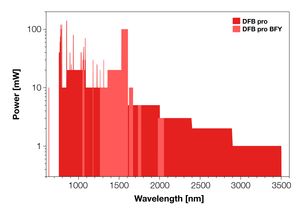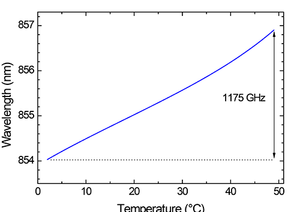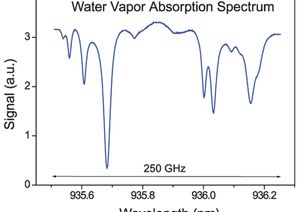 DFB pro: Available Wavelengths and output power
DFB pro: Available Wavelengths and output power



DFB pro
Distributed-feedback laser
- Single-frequency laser with distributed-feedback diode
- Available wavelengths: 633 nm, 760 nm .. 3500 nm
- Mode-hop free tuning range: Up to 1400 GHz
- Reliable operation even in harsh environments
- 3 laser heads – wide range of options
Distributed feedback (DFB) lasers unite wide tunability and high output power. The frequency-selective element – a Bragg grating – is integrated into the active section of the semiconductor and ensures continuous single-frequency operation. Due to the absence of alignment-sensitive components, DFB lasers exhibit an exceptional stability and reliability. The lasers work under the most adverse environmental conditions – even in the Arctic or in airborne experiments.
Three laser heads, designed specifically for DFB lasers, accommodate different diode packages: the compact DFB pro and its “big brother” DFB pro L integrate 9 mm, TO3-type and TO8-Type diodes. The DFB pro BFY offers a dedicated laser head for butterfly-type diodes.
Owing to their wide continuous tuning range, DFB lasers lend themselves particularly to applications in atomic and molecular physics, gas sensing, phase-shifting interferometry, and continuous-wave terahertz generation.
For a selection of available DFB/DBR laser diodes, please refer to the online stock list. If you are interested in a wavelength not shown there, please inquire – TOPTICA can provide customized DFB systems at virtually any wavelength between 760 nm and 3500 nm.
-
Specification
DFB pro DFB pro DFB pro L DFB pro BFY Center wavelengths 633 nm 760 nm - 3500 nm 1017 nm .. 2000 nm * Output power up to 8 mW 2 .. 150 mW 10 .. 100 mW
(fiber output)Tuning range up to 0.25 nm 2 .. 6 nm 2 .. 5 nm, mode-hop free -
Additional Top Seller
DFB pro 633
Laser system combining our DLC pro controller with a DFB pro laser head at 633 nm
- Single-frequency laser with distributed-feedback diode at 633 nm
- With DLC pro controller
- With SmartDock for fiber coupling
DFB pro 633 Min Wavelength, including tuning 632.5nm Max Wavelength, including tuning 633.5nm Mode-hop free tuning range 200 GHz Free-Space power at lowest wavelength 8 mW - Additional Information
-
Options
Fiber Delivery

Fiber Delivery (FD) is optionally available with TOPTICA's patented fiber coupler FiberDock and a suitable polarization maintaining (PM) fiber. FiberDock provides highest single-mode fiber coupling efficiencies, easy alignment and at the same time highest stability.
For most lasers, we specify a PER behind fiber of >20 dB with our Fiber Delivery option. Please also inquire about Long Life and High Power fibers as well as fiber splitters. Optical isolation is mandatory for fiber coupled diode laser systems.Optical Isolation


Isolators are used to protect the laser diode against back reflections. This not only prevents damage to the diode but also ensures untroubled tuning and single-frequency operation. Fiber-coupling with angle-polished fibers (both ends) requires at least a single-stage isolator (> 30 dB). Double-stage isolators are needed if reflections from the experiment into the laser are expected. Fiber-coupling with non-angle-polished fibers also requires a double-stage isolator (> 60 dB). Beam Shaping

To shape elliptical laser beams into round profiles, either an anamorphic prism pair (APP) or cylindrical lenses are used. The compression ratio is set at the factory. Bias-T

The DL pro (HP) has two modulation inputs that allow current modulation frequencies of up to 150 MHz. A Bias-T allows even higher current modulation frequencies of up to several GHz, depending on the diode. It is also suited for seed lasers of TA or NLO systems but not for DL pro HP lasers. Electronics Modules A broad variety of electronic locking modules is available for frequency stabilization. -
Applications
- Alkaline spectroscopy
- Molecular physics
- Gas sensing
- Interferometry and holography
- Optical communication
- Magnetic-field measurement
- Continuous-wave terahertz generation
- Semicon metrology
- phase-shifting Interferometry
-
Downloads
- Product Brochure: Optical Clocks
- Product Brochure: Rydberg Flyer
- Technical Drawings DFB pro
- Technical Drawings DFB pro with SmartDock
- Technical Drawings DFB pro L
- Technical Drawings DFB pro L with FiberDock
- Technical Drawings DFB pro BFY
-
Literature
- Application Note: Biomagnetic measurements benefit from laser know-how
- Application Note: 12 Orders of Coherence control
- Scientific Publication: S. Lee, et al., Terahertz-visible two-photon rotational spectroscopy of cold OD-; Phys. Rev. A 93 (2016)
- S. Kraft et al., Rubidium spectroscopy at 778-780 nm with a distributed feedback laser diode, Laser Phys. Lett. 2:2 (2005)
- F. Friederich et al., Phase-locking of the beat signal of two distributed-feedback diode lasers to oscillators working in the MHz to THz range, Opt. Express 18:8 (2010)
- F. Friederich et al., Hybrid continuous-wave demodulating multipixel terahertz imaging systems, IEEE Transact. Microwave Theory and Techn. 58:7 (2010)
- K. Niemi et al., The role of helium metastable states in radio-frequency driven helium–oxygen atmospheric pressure plasma jets: measurement and numerical simulation, Plasma Sources Sci. Technol. 20:5 (2011)
- Application Note: Phase and Frequency Locking of Diode Lasers
- Application Note: Linewidth Measurement of Diode Lasers
-
Related Products
- DLC pro: Fully digital driver electronics. Low noise with inuitive multi-touch UI
- CTL: Continuously tunable diode laser
- DL pro: The ultimate Littrow ECDL - stable and user friendly
- TA pro: pro series ECDL with tapered amplifier
- BoosTA pro: Semiconductor amplifier for higher powers
- Frequency converted diode lasers for all other wavelengths
- Laser Locking Electronics: A broad variety is available for frequency stabilization
- AR, FP, and DFB Laser Diodes
- Numerous Photonicals, tools and helpful equipment for working with lasers, for example Fabry-Perot Interferometers


